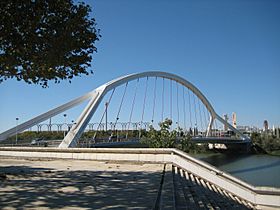Puente de la Barqueta facts for kids
Quick facts for kids Puente de la Barqueta |
|
|---|---|

The Puente de la Barqueta, viewed from the left side of the Guadalquivir river
|
|
| Coordinates | 37°24′16″N 5°59′50″W / 37.40444°N 5.99722°W |
| Carries | Motor vehicles, pedestrians, and bicycles |
| Crosses | Guadalquivir river |
| Locale | Seville (Andalusia–Spain) |
| Official name | Puente Mapfre |
| Preceded by | Puente del Alamillo |
| Followed by | Pasarela de la Cartuja |
| Characteristics | |
| Total length | 214 m. |
| Width | 21,4 m. |
| History | |
| Designer | Juan J. Arenas & Marcos J. Pantalerón |
| Construction begin | 1989 |
| Construction end | 1992 |
The Puente de la Barqueta is a famous bridge in the city of Seville, Spain. Its name means "bridge of the barges," which comes from an old gate nearby. Officially, it is called Puente Mapfre. This bridge crosses the Alfonso XII channel of the Guadalquivir river. It was built to help people get to the Isla de la Cartuja (Cartuja Island).
Building the Bridge
The Puente de la Barqueta was built between 1989 and 1992. It was a very important project for the Universal Exposition Expo '92. The bridge was designed to be the main entrance to the Expo site.
Design and Purpose
The bridge is 214 meters (about 702 feet) long and 21.4 meters (about 70 feet) wide. It carries cars, people walking, and bicycles. Its main job was to connect Seville city with the Expo '92 area on Cartuja Island. This made it easy for visitors to reach the big event.
Who Designed It?
The Puente de la Barqueta was designed by two engineers: Juan J. Arenas and Marcos J. Pantalerón. They created a strong and modern bridge that still stands today.
The Bridge Today
Even after Expo '92 ended, the Puente de la Barqueta remains an important part of Seville. It helps connect different parts of the city. It is a great example of the special buildings made for the Expo.
See also
 In Spanish: Puente de la Barqueta para niños
In Spanish: Puente de la Barqueta para niños

